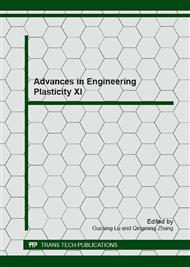p.205
p.211
p.215
p.219
p.223
p.227
p.231
p.235
p.239
Viscosity of Amorphous Materials during Glass-Forming: More from the Adam-Gibbs Law
Abstract:
This study aims to investigate the microscopic origin of viscosity by simplifying an amorphous system to a mixture of many independent atomic subsystems. The response of the macroscopic system is then taken as an ensemble average of the relaxations of such subsystems. The result shows that with the reduction of temperature, the overall viscosity changes from the harmonic mean of the subsystems, which is dominated by the fast relaxations, to the arithmetic mean governed by the slowest relaxation. The successful application of our model to the amorphous Selenium indicates the model captures the fundamental mechanism of the viscosity variation.
Info:
Periodical:
Pages:
223-226
Citation:
Online since:
January 2013
Authors:
Keywords:
Price:
Сopyright:
© 2013 Trans Tech Publications Ltd. All Rights Reserved
Share:
Citation:


